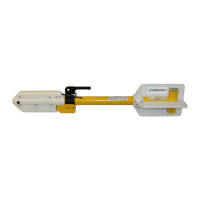Geometrics Inc. G-882 Cesium Marine Magnetometer Page 28
Total field magnetometers like the optically pumped cesium magnetometer
are passive devices, they do not send out waves or pulses. They measure
distortions in the earth’s normally homogenous magnetic field and can sense
distortions due to ferrous objects at great distances.
The basic rule of thumb is that one ton (1000 Kg) of steel or iron will give us a
1nT anomaly at 100 ft or 30m. Since the amount of distortion falls off as the
cube with distance (compare a metal detector which falls off as the inverse 6
th
power!) and is linear with mass, every time we cut the distance in half, we can
see 1/8
th
the mass. Therefore, we can sense 250 lbs (100kg) at 50 feet
(15m), or 30lbs (15kg) at 25 feet (8m), or 4lbs (2kg) at 12 feet (4m).
However this is not the whole story. The factors given above are for induced
magnetic fields only. Many targets also have remanent or permanent
magnetic effects (meaning they have become magnetized either in production
or by the earth’s field) and can therefore have larger anomalies by a factor of
3 or 5 or more. Also many hollow objects like barrels or other tubular
structures appear as though they are solid due to self-shielding from the
earth’s field, and thus have much larger anomalies than their mass would
predict alone. Pipes fall off as the inverse square and are thus detectable at
even greater distances. Please see our Applications Manual for Portable
Magnetometers for more information. Our website contains additional FAQ
questions.
4.2 Performance
Geometrics G−882 magnetometer produces a Cesium Larmor frequency output
at 3.49872 Hz per nT (in this text, nT refers to nanotesla or gamma or 10
-5
gauss). Thus, in a nominal 50,000 nT field this frequency is about 175 kHz. The
output of the system is a continuous sine wave at the Larmor frequency. The
typical signal amplitude is approximately 2 volts peak-to-peak at optimal
orientation of the sensor.
This frequency is counted with the internal counter at 10 readings per second but
the cycle rate can be set to one reading every 3 seconds to 20 times per
second.. The G−882 is intended for use in marine applications, and operates
over the earth's magnetic field range of 20,000 to 100,000 nT.
Absolute accuracy (relative to National Bureau of Standards facility at
Fredricksburg, VA) depends on sensor orientation, internal light shift and the
accuracy of the external counter's time base. Typically cesium magnetometers
offer absolute accuracies to within ±2nT of this standard. Since the offset if any
is constant (no drift over the lifetime of the product) this is of no consequence in
survey activities. Orientation error of the G−882 does not exceed 1 nT p-p (peak-
to-peak) throughout the entire 360º polar and equatorial spins of the sensor.
Like all magnetometers, performance of the G−882 in a mobile installation is
primarily dependent upon the stability of the tow fish and the proximity to large
steel objects (e.g., the tow vessel). Navigational or positional errors, radiated

